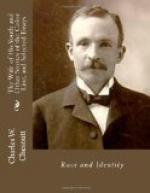The family were at a loss what to call him. To any inquiry as to his name he answered no more than to other questions.
“He come jes’ befo’ Sherman,” said Needham, after a few weeks, “lack John de Baptis’ befo’ de Lawd. I reckon we bettah call ’im John.”
So they called him John. He soon learned the name. As time went on Cicely found that he was quick at learning things. She taught him to speak her own negro English, which he pronounced with absolute fidelity to her intonations; so that barring the quality of his voice, his speech was an echo of Cicely’s own.
The summer wore away and the autumn came. John and Cicely wandered in the woods together and gathered walnuts, and chinquapins and wild grapes. When harvest time came, they worked in the fields side by side,—plucked the corn, pulled the fodder, and gathered the dried peas from the yellow pea-vines. Cicely was a phenomenal cotton-picker, and John accompanied her to the fields and stayed by her hours at a time, though occasionally he would complain of his head, and sit under a tree and rest part of the day while Cicely worked, the two keeping one another always in sight.
They did not have a great deal of intercourse with other people. Young men came to the cabin sometimes to see Cicely, but when they found her entirely absorbed in the stranger they ceased their visits. For a time Cicely kept him away, as much as possible, from others, because she did not wish them to see that there was anything wrong about him. This was her motive at first, but after a while she kept him to herself simply because she was happier so. He was hers—hers alone. She had found him, as Pharaoh’s daughter had found Moses in the bulrushes; she had taught him to speak, to think, to love. She had not taught him to remember; she would not have wished him to; she would have been jealous of any past to which he might have proved bound by other ties. Her dream so far had come true. She had found him; he loved her. The rest of it would as surely follow, and that before long. For dreams were serious things, and time had proved hers to have been not a presage of misfortune, but one of the beneficent visions that are sent, that we may enjoy by anticipation the good things that are in store for us.
III
But a short interval of time elapsed after the passage of the warlike host that swept through North Carolina, until there appeared upon the scene the vanguard of a second army, which came to bring light and the fruits of liberty to a land which slavery and the havoc of war had brought to ruin. It is fashionable to assume that those who undertook the political rehabilitation of the Southern States merely rounded out the ruin that the war had wrought—merely ploughed up the desolate land and sowed it with salt. Perhaps the gentler judgments of the future may recognize that their task was a difficult one, and that wiser




